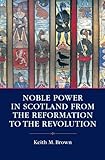Noble Society In Scotland : Wealth, Family and Culture, from Reformation to Revolution / Keith Brown.
Material type: TextPublisher: Edinburgh : Edinburgh University Press, [2022]Copyright date: ©2003Description: 1 online resource (370 p.) : 4 maps, 30 half-tone illustrationsContent type:
TextPublisher: Edinburgh : Edinburgh University Press, [2022]Copyright date: ©2003Description: 1 online resource (370 p.) : 4 maps, 30 half-tone illustrationsContent type: - 9780748612994
- 9781474465434
- 305.5/223/09411
- HT647
- online - DeGruyter
- Issued also in print.
| Item type | Current library | Call number | URL | Status | Notes | Barcode | |
|---|---|---|---|---|---|---|---|
 eBook
eBook
|
Biblioteca "Angelicum" Pont. Univ. S.Tommaso d'Aquino Nuvola online | online - DeGruyter (Browse shelf(Opens below)) | Online access | Not for loan (Accesso limitato) | Accesso per gli utenti autorizzati / Access for authorized users | (dgr)9781474465434 |
Browsing Biblioteca "Angelicum" Pont. Univ. S.Tommaso d'Aquino shelves, Shelving location: Nuvola online Close shelf browser (Hides shelf browser)

|

|

|

|

|

|

|
||
| online - DeGruyter Women and Contemporary Scottish Politics : An Anthology / | online - DeGruyter Devolution - Scottish Answers to Scottish Questions? / | online - DeGruyter Narratives for a New Belonging : Diasporic Cultural Fictions / | online - DeGruyter Noble Society In Scotland : Wealth, Family and Culture, from Reformation to Revolution / | online - DeGruyter The University of Glasgow : 1451-1996 / | online - DeGruyter Sectarianism in Scotland / | online - DeGruyter Deleuze and Literature / |
Frontmatter -- Contents -- Acknowledgements -- Glossary -- Map -- Introduction. The Early Modern Scottish Nobility -- Part 1. Wealth -- 1. Landlords -- 2. Entrepreneurs -- 3. Expenditure -- 4. Debt -- Part 2. Family -- 5. Marrying -- 6. Spouses -- 7. Children -- Part 3. Culture -- 8. Education -- 9. Leisure -- 10. Religion -- 11. Death -- Conclusion -- Notes -- Bibliography -- Index
restricted access online access with authorization star
http://purl.org/coar/access_right/c_16ec
Even in the sixteenth and seventeenth centuries it was conventional for humanist writers and their Enlightenment successors to regard the nobility which dominated early modern Scottish society and politics as violent, unlearned, and backward - at best conservatively bound to feudal codes of behaviour; at worst, brutal, corrupt and anarchic. It is a view that prevails still. Keith Brown takes issue with this.The author draws on extensive research in the rich archives of the Scottish noble houses to demonstrate that the conventional view of the Scottish nobility is wrong. He shows that the nobility were as steeped in contemporary European debates and movements as they were rooted in local society. Far from holding back Scotland's economic and cultural development, they embraced economic change, seized financial opportunities, led the way in the pursuit of Renaissance ideals through their own learning and in the education of their children, and were partners in religious reform. Professor Brown makes extensive comparisons with the noble societies elsewhere in Europe to reveal how the differences and above all the similarities between the lives of Scottish nobles and their peers abroad.Elegantly written and illustrated with a wealth of contemporary incident and anecdote, the book presents an intimate and vivid picture of noble life in Scotland. It challenges and will change perceptions of early modern Scotland.Noble Society in Scotland is the first of two related books on the subject. The second, on noble power and the relations between the nobility, state and monarchy, will be published by EUP in 2003.
Issued also in print.
Mode of access: Internet via World Wide Web.
In English.
Description based on online resource; title from PDF title page (publisher's Web site, viewed 02. Mrz 2022)


